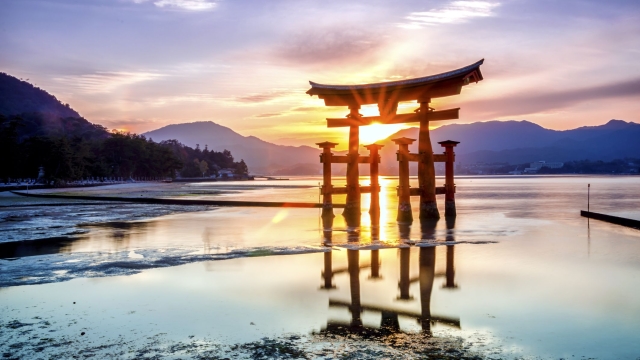/GettyImages-986460262-5c01b5b446e0fb000114d715.jpg)
Japan is a land steeped in history, where the whispers of the ancients echo through lush forests and tranquil mountains. Amongst its rich tapestry of culture and tradition, the Shinto shrines stand as timeless sanctuaries, inviting visitors to immerse themselves in a world of spirituality and reverence. These sacred spaces, intricately woven into the very fabric of Japanese life, offer not just a glimpse into the country’s religious practices, but also a deep connection to nature and the divine.
As we wander through the serene paths lined with towering torii gates, the allure of Shinto shrines in Japan unfolds like the delicate petals of a cherry blossom. Each shrine tells a unique story, from the bustling urban centers to the quiet countryside, providing a sanctuary for reflection and connection with kami, the spirits that dwell in all aspects of the natural world. Join us on this enchanting journey as we explore the history, architecture, and spiritual significance of these remarkable sites, where every stone and tree seems to hold the whispers of the ancients.
The Spiritual Significance of Shinto Shrines
Shinto shrines in Japan are not merely architectural wonders; they embody the spiritual heart of the Shinto faith. Each shrine serves as a sacred space where humans can connect with kami, the localized spirits revered in Shintoism. The design and location of these shrines are deeply intentional, often situated in places of natural beauty, which further emphasizes the belief that the divine is present in the world around us. This connection between nature and spirituality invites visitors to experience a sense of peace and reverence.
When one enters a Shinto shrine, rituals such as purification, offering, and prayer are commonplace. These practices serve as a means of communication with the kami, fostering a profound sense of humility and gratitude. The rituals are often steeped in tradition and can vary from one shrine to another, reflecting the unique history and significance of each site. The act of visiting a shrine allows individuals to not only seek blessings for themselves but also to honor their ancestors and the community, reinforcing a shared spiritual heritage.
Moreover, Shinto shrines play a vital role in the cultural identity of Japan. Festivals and ceremonies held at these shrines through the changing seasons weave together the spiritual and social fabric of the community. They are places where traditions are preserved and passed down through generations, highlighting the importance of continuity in Shinto practice. In essence, Shinto shrines in Japan are both spiritual sanctuaries and vibrant cultural hubs that nurture the soul and inspire a collective reverence for the sacred.
Architectural Marvels: Design and Structure
Shinto shrines in Japan are renowned for their striking architectural designs that harmoniously blend with the natural environment. One of the most distinctive features is the use of wooden structures, which are often left unpainted to showcase the beauty of the natural wood grain. The roofs are typically made from thatch or wooden shingles, featuring a gentle, curving shape that resembles the forms found in nature. This design not only serves an aesthetic purpose but also reflects the Shinto belief in living in harmony with the surroundings.
The layout of Shinto shrines often follows a prescribed pattern, emphasizing a path of purification. Visitors usually begin their journey at the torii gate, a symbolic entry point that marks the transition from the mundane to the sacred. As they continue along the approach, they may encounter various elements such as the chozuya, where they cleanse their hands and mouth, and the honden, which houses the kami, or deity, worshipped at the shrine. Each space is carefully curated to create a contemplative atmosphere, inviting reflection and connection with the spiritual.
Additionally, the incorporation of natural elements into shrine architecture is a notable characteristic. Many shrines are constructed near sacred trees, rivers, or mountains, articulating a deep reverence for nature. Stones, water, and even the landscape itself often become integral parts of the shrine. This conscious design reflects the Shinto philosophy of animism, acknowledging the presence of spirits within nature. As a result, visiting these shrines offers not only a glimpse into Japan’s rich spiritual heritage but also an experience that is intertwined with the beauty of the Japanese landscape.
Rituals and Traditions at the Shrines
At Shinto shrines in Japan, rituals and traditions play a vital role in preserving the spiritual heritage and cultural practices of the country. One of the most significant rituals is the "hatsu-mode," which takes place during the New Year. This is the first visit to a shrine in the year, where individuals and families come to pay their respects and offer prayers for health, happiness, and prosperity. Visitors often purchase talismans and omamori, which are believed to provide protection and blessings throughout the year.
Another essential tradition involves offerings made to the kami, or spirits, residing at the shrines. Worshippers bring various items such as rice, sake, and salt, which are presented at the altar during ceremonies. These offerings express gratitude and seek favor from the deities, embodying the deep-rooted connection between the people and the divine. Special occasions, such as weddings and festivals, often incorporate elaborate ceremonies that highlight the rich symbolism and meaningful practices inherent in Shinto.
Matsuri, or festivals, are also a fundamental part of life at Shinto shrines in Japan. These vibrant celebrations often involve processions, traditional music, and dance, serving both as a form of worship and a communal gathering. Local communities actively participate, reinforcing their ties to the shrine and fostering a sense of belonging. Each shrine has its own unique matsuri, reflecting local customs and the specific characteristics of its kami, showcasing the diversity and beauty of Shinto traditions across the country.
Preserving the Legacy: Modern Challenges
As guardians of Japan’s spiritual heritage, Shinto shrines face numerous challenges in the modern era. One of the most pressing issues is the decline in traditional practices and the waning interest of younger generations in Shinto rituals. With urbanization and the fast-paced lifestyle that comes with it, many people find it difficult to connect with their cultural roots, leading to a significant reduction in shrine visits and participation in festivals. The dwindling number of practitioners threatens the transmission of ancient customs and beliefs that have been upheld for centuries.
神社
Environmental factors also pose challenges to the preservation of these sacred sites. Many shrines are located in areas susceptible to natural disasters, such as earthquakes, floods, and typhoons. The need for structural integrity and restoration efforts has become paramount as climate change intensifies these risks. Additionally, maintaining the natural landscapes, which are integral to Shinto beliefs, requires ongoing conservation efforts. Resources for these undertakings are often limited, making it increasingly difficult to safeguard these sites for future generations.
Financial strains further complicate the preservation of Shinto shrines. As the number of visitors declines and donations wane, many shrines struggle to maintain their facilities and carry out necessary upkeep. This economic pressure can lead to a diminished capacity to host festivals, ceremonies, and educational programs that foster understanding and appreciation of Shinto beliefs. Finding sustainable methods to support these sacred spaces while adapting to modern expectations is essential for ensuring the continued relevance and resilience of Shinto shrines in contemporary society.


